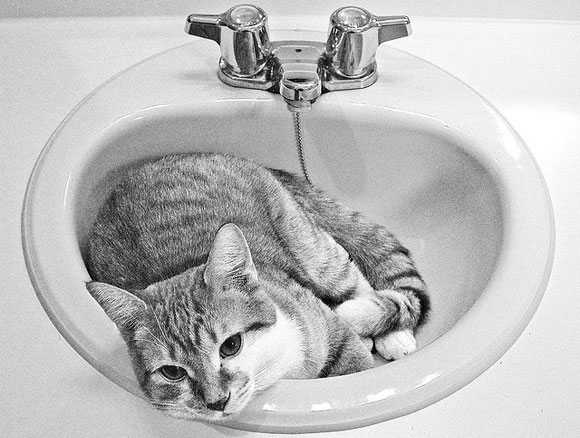Originally Published: August 30, 2010
What your sink and faucet can teach you about UX
When you look at a sink, you probably don’t recognize it as an object that can teach us a valuable lesson about design. They’ve been around, in one form or another, for centuries. They just are.
Look at this sink.

There’s a cat in this sink. But that’s not all. Look at the faucet — it’s nearly flush with the back edge. Most faucets are positioned like this.
If you are anything like me, your mind is on autopilot when you turn on the faucet to wash your hands. Next time, try slowing down and thinking about what you are doing. With the faucet against the back edge, you twist your hands around in the flow of water, rinsing one area at a time while avoiding the sides (those evil, grungy sides). Your hands are never fully immersed in the stream.
Consider the alternative: A sink that positions its faucet further into the basin — your hands have more room to maneuver and can get clean in whatever manner they see fit. That freedom provokes a sensation of pleasantness, but you don’t understand or even consider why it does. Here’s a theory: The experience is better because the design is right for how you use it.
Before the introduction of indoor plumbing, sinks were basins. You would fill your basin with water, perform hygienic tasks, and dump it out. Faucets came later as an add-ons that made it easier to fill the basin—you still washed your hands in the basin, not in the stream of water. Early users wanted their faucet out of the way.
Today’s faucets closely resemble their ancestors: The faucet head is still positioned near the edge of the basin. This would be fine if we still filled the basin before using it, but that behavior is less and less common. In many public restrooms, it is even impossible to stopper the water unless you’re packing your own or if you can plug the drain with paper towel. Our dominant faucet design creates a poor hand-washing experience.
 How did we get here? We iterated when we should have innovated. The assumptions behind sink and faucet design changed and we stuck with a conventional approach. Don’t get me wrong—conventions are very useful—but, reliance on design patterns and convention becomes dangerous when assumptions change. How we were taught to do something yesterday could be the wrong approach today.
How did we get here? We iterated when we should have innovated. The assumptions behind sink and faucet design changed and we stuck with a conventional approach. Don’t get me wrong—conventions are very useful—but, reliance on design patterns and convention becomes dangerous when assumptions change. How we were taught to do something yesterday could be the wrong approach today.
When making design decisions, we need to stop often and think critically about assumptions. That’s what the sink can teach us.